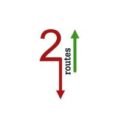A CFD, or contract for difference, is a financial agreement between a trader and a broker. It essentially allows you to speculate on the price movements of an underlying asset, like stocks, forex, commodities, or even cryptocurrencies, without actually owning the asset itself.
Here’s a breakdown of CFDs:
- Contract: It’s an agreement between you and the broker outlining the terms of the trade.
- Difference: The settlement focuses on the difference in the value of the asset between when you enter the contract (open the trade) and when you exit (close the trade).
- Underlying Asset: You don’t directly own the asset (stock, currency, etc.) in a CFD. You’re just speculating on its price movement.
Key Points about CFDs:
- Leverage: CFD trading often involves leverage, meaning you can control a larger position size than your initial deposit. This allows for potentially amplified profits but also magnified losses.
- Long or Short: You can go long (betting the price will rise) or short (betting the price will fall) with CFDs, offering flexibility in various market conditions.
- Cash Settlement: CFDs are typically cash-settled contracts. This means you don’t receive the physical asset itself; you just receive or pay the difference in value based on your trade direction.
CFD vs. Owning the Asset:
- Ownership: With CFDs, you don’t own the underlying asset, so you don’t receive any dividends or voting rights that might come with ownership.
- Costs: Owning an asset may involve holding fees or custody charges, while CFDs might have bid-ask spreads and financing costs.
Overall, CFDs are a complex financial instrument that can be risky due to leverage. It’s crucial to understand how they work and carefully manage your risk before entering any CFD trades.
